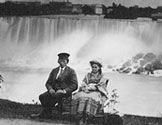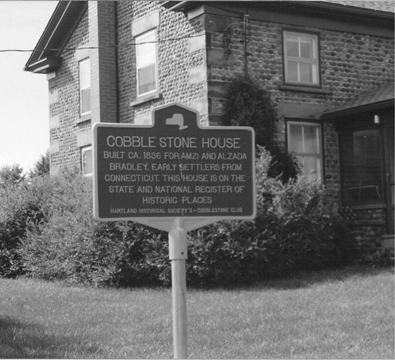

|
||||||||||||||||||||||||||||||||||||||||||
|
| ||||||||||||||||||||||||||||||||||||||||||
 |
 |
 |
 |
 Cobblestones  While most home construction in Niagara County today is wood frame or brick, which was not always the case. From about 1825 to the Civil War, many homes were built with cobblestones. This unique building method is now a lost art, as many of the secrets of the trade went to the grave with the home contractors of the period. The story began when massive glaciers that once covered this area melted and receded northward. The melt waters formed the Great Lakes. Ancient Lake Iroquois, the forerunner of Lake Ontario, also receded leaving behind its beach, now Ridge Road – Route 104. Wave action over thousands of years produced countless smooth, rounded stones, or cobblestones, which were deposited on the ancient lake bed between the Ridge and the shore of Lake Ontario. Early farmers, at first, thought the stones were a nuisance and made piles of the culprits at the edges of their fields along the Lake Ontario Plain. With the completion of the Erie Canal, out of work stone masons viewed the piles of rocks with great interest. Their work with this new building material created a fascinating new era in American architecture. Historians have recorded construction of about 600 cobblestone buildings in the country, with 500 located in New York State and 50 in Niagara County. To qualify as a true cobblestone building, the stones had to be all of uniform size and laid in straight rows. Sometimes, the home was built quickly with large fieldstones to provide a quick residence for the builder. Then, a second wall made from cobblestones was added, separated with an air space from the first wall. Walls were usually 18 inches or more thick. As a rule, the most perfect stones were used as a veneer on the front of the building and the other walls were more irregular. Usually, the back wall was not finished with cobblestones, and the field stones were left exposed. Some folks described this as “a Queen Ann front and a Betty Jane behind.” This unique style of building became a lost art for several reasons. With today’s prices, it would be enormously expensive for a contractor to spend the three to four years needed to complete the average cobblestone house. Also, the method of construction was a jealously guarded secret. Tradesmen were tight lipped when it came to the profession, and the mixture used for mortar for cobblestone buildings was never shared. Rumor has it that all construction would cease on the job if any observer came within a half-mile of the job site and guards were often posted to keep away rival craftsmen. Unfortunately, many cobblestone houses are falling to the wrecking ball or just disappearing through neglect. With high heating bills and expensive repairs, some people can no longer afford to maintain these structures. Development has also taken its toll on these once beautiful homes. Douglas Farley, Director Ann Marie Linnabery Erie Canal Discover Center 24 Church St. Lockport NY 14094 716.439.0431 CanalDiscovery@aol.com www.NiagaraHistory.org |
|